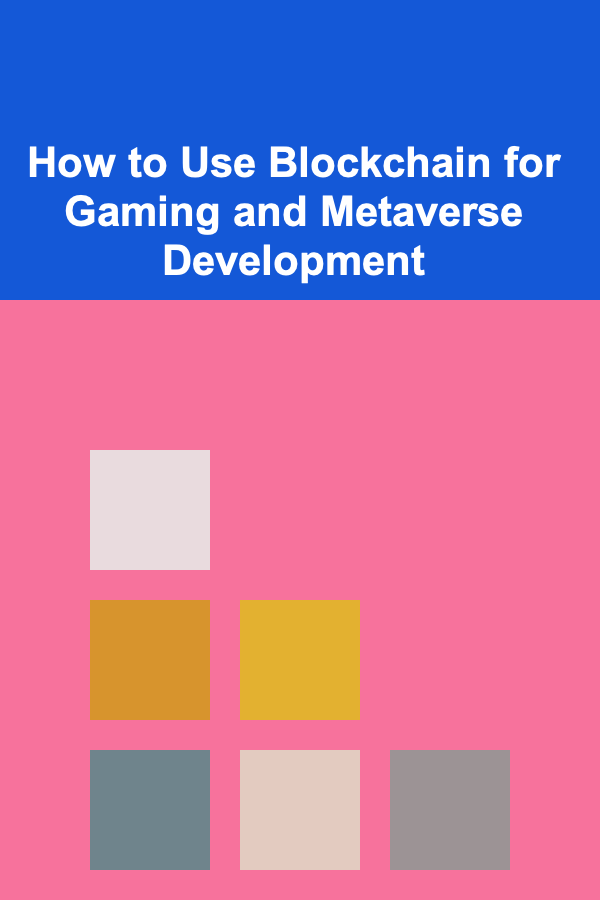
How to Use Blockchain for Gaming and Metaverse Development
ebook include PDF & Audio bundle (Micro Guide)
$12.99$11.99
Limited Time Offer! Order within the next:

Blockchain technology has evolved far beyond its initial use case in cryptocurrency. Its decentralized, transparent, and secure nature makes it a powerful tool for various applications, particularly in gaming and the development of the metaverse. The gaming industry has always been at the forefront of adopting new technologies, and blockchain's potential to revolutionize how games are created, played, and monetized is increasingly becoming evident. In this article, we will explore how blockchain can be leveraged in gaming and the metaverse development, covering its applications, challenges, and the future prospects it holds.
Introduction to Blockchain Technology
At its core, blockchain is a distributed ledger technology that ensures data is recorded in a transparent, immutable, and decentralized manner. Each block in a blockchain contains a list of transactions that are verified by participants in the network, making it nearly impossible to alter or erase data. The decentralized nature of blockchain eliminates the need for a central authority, allowing for peer-to-peer interactions without intermediaries.
Key Characteristics of Blockchain:
- Decentralization: No single entity controls the network.
- Transparency: All transactions are visible to everyone on the network.
- Security: Data is cryptographically secured, making it resistant to tampering.
- Immutability: Once data is recorded on the blockchain, it cannot be changed or erased.
- Smart Contracts: Self-executing contracts that automate processes when certain conditions are met.
These characteristics make blockchain highly suitable for industries like gaming and the metaverse, where transparency, ownership, and security are critical.
Blockchain in Gaming
1. True Ownership of In-Game Assets
One of the most transformative aspects of blockchain in gaming is the concept of true ownership. In traditional gaming, players buy in-game items, skins, characters, and other digital assets, but these assets are controlled by the game developers or publishers. Players don't actually own these items; they are licensed to use them within the game. Blockchain, particularly through the use of non-fungible tokens (NFTs), changes this paradigm.
With NFTs, players can own, buy, sell, and trade in-game assets as they would physical goods. For example, in games like Decentraland or Axie Infinity, players can own land, characters, and other assets that exist outside of the game environment on the blockchain. This ownership is verifiable, and players have the freedom to trade these assets across different games or platforms, creating an economy of digital goods that transcends individual games.
2. Play-to-Earn (P2E) Models
Blockchain has given rise to play-to-earn (P2E) gaming models, where players can earn real-world value through in-game activities. Traditional gaming monetization methods, such as in-game purchases and subscription models, rely on players spending money within the game. In contrast, P2E games reward players for their time and effort with cryptocurrencies or NFTs, which can be exchanged for real-world value.
Games like Axie Infinity and The Sandbox have popularized this model, allowing players to earn tokens or assets by completing tasks, engaging in battles, or creating content within the game. These earned assets can then be sold or used within the game, providing players with a real incentive to participate in the game economy.
3. Decentralized Game Economies
Blockchain allows for the creation of decentralized game economies, where players can engage in a broader, more dynamic marketplace that isn't controlled by a single entity. Developers can create tokens specific to their games, which can be used for transactions, rewards, or governance within the game's ecosystem.
For example, games like Gods Unchained use blockchain to power their card trading system, where each card is a token that can be traded, sold, or bought. By allowing players to control the market for in-game items, blockchain fosters a more open and competitive economy, providing players with more control and ownership.
4. Interoperability Between Games
One of the exciting potentials of blockchain in gaming is the ability to facilitate interoperability between different games. Blockchain-powered assets, such as NFTs, can exist outside of a single game's environment, enabling them to be used in other games. For instance, an in-game item purchased in one game could be transferred and used in another, creating a shared digital economy across multiple platforms.
The development of cross-game interoperability is still in its early stages, but it has the potential to transform the way games are designed and how players interact with digital assets. Imagine a scenario where a weapon in one game can be used in a completely different game, creating a seamless experience for players.
5. Enhanced Security and Anti-Cheating Mechanisms
Blockchain technology's inherent security features provide a robust solution to combat cheating and fraud in games. With the transparent nature of blockchain, players' actions, transactions, and in-game assets can be verified in real-time. This makes it more difficult for malicious actors to manipulate the game's economy, cheat, or exploit vulnerabilities.
Additionally, smart contracts can be used to ensure that game rules are adhered to automatically. For example, a smart contract could govern the conditions for a tournament, ensuring that players follow the rules and are rewarded fairly without the need for human oversight.
Blockchain in the Metaverse
The metaverse is often envisioned as a digital universe composed of interconnected virtual worlds, environments, and experiences. It encompasses virtual reality (VR), augmented reality (AR), social media, digital commerce, and more. Blockchain plays a crucial role in enabling the metaverse's decentralized nature, ensuring that users have true ownership and control over their digital identities, assets, and experiences.
1. Digital Identity and Ownership
In the metaverse, users need a way to establish their digital identities and securely own virtual assets like clothing, skins, real estate, and more. Blockchain can provide a secure, verifiable system for managing digital identities, allowing users to own and control their online persona across various virtual worlds.
Blockchain-based identity solutions, like Self-Sovereign Identity (SSI), allow users to have complete control over their personal data. Rather than relying on centralized platforms to manage their identity, users can store their credentials on a blockchain, ensuring that they are always in control of their virtual identity.
2. Land Ownership and Virtual Real Estate
One of the most significant applications of blockchain in the metaverse is virtual real estate. Games and platforms like Decentraland , The Sandbox , and Somnium Space allow users to buy, sell, and trade virtual land, with ownership and transactions verified on the blockchain. Just like physical real estate, virtual land can appreciate in value over time, creating opportunities for investment and speculation.
Blockchain enables transparent ownership records, ensuring that land ownership in the metaverse is secure and easily transferable. Users can also monetize their virtual land by building structures, offering services, or hosting events, creating a thriving virtual economy.
3. Interoperable Virtual Goods and NFTs
Just like in gaming, blockchain allows for interoperability of virtual goods in the metaverse. NFTs are used to represent ownership of unique digital items, such as virtual clothing, accessories, and artwork. These NFTs can be bought, sold, and traded across different virtual environments, creating an economy where digital assets have real-world value.
The use of NFTs in the metaverse allows users to take their digital possessions from one platform to another, ensuring that their items remain valuable and usable, regardless of which virtual world they are in.
4. Decentralized Governance in the Metaverse
Decentralized governance is another key benefit of using blockchain in the metaverse. Blockchain allows users to participate in the decision-making process regarding the development and operation of virtual worlds. Through decentralized autonomous organizations (DAOs), users can vote on issues like land distribution, the introduction of new features, or changes to the platform's rules.
This form of governance ensures that control is spread across the user base, rather than being centralized in the hands of a few developers or corporations. DAOs are already being used in some metaverse platforms to enable users to shape the future of their virtual environments.
5. Digital Economy and Tokenization
The metaverse's economy will rely heavily on the tokenization of both virtual and real-world assets. Blockchain enables the creation of various types of tokens---whether they represent virtual goods, services, or even real-world assets. These tokens can be used for transactions, rewards, and incentives within the metaverse.
For example, a user might earn tokens by participating in activities within the metaverse, such as attending events, playing games, or creating content. These tokens can then be spent on virtual goods or exchanged for cryptocurrencies, making the metaverse a self-sustaining economic ecosystem.
Challenges in Using Blockchain for Gaming and the Metaverse
While blockchain holds great promise, there are several challenges that developers and users must address before it can reach its full potential in gaming and the metaverse.
1. Scalability
Blockchain networks, particularly those using proof-of-work (PoW) consensus mechanisms, can struggle with scalability. The number of transactions per second (TPS) is limited, which can result in network congestion and slow transaction times, especially in a high-demand environment like gaming or the metaverse. Solutions like layer 2 scaling and newer consensus mechanisms (e.g., proof-of-stake (PoS)) are being developed to address these issues, but scalability remains a challenge.
2. User Experience and Adoption
Blockchain technology can be complex for users who are unfamiliar with it. Issues like managing wallets, understanding gas fees, and handling private keys can be daunting for beginners. The onboarding process for blockchain-based games and metaverse platforms needs to be user-friendly to attract mainstream users.
3. Regulation and Legal Concerns
The legal status of blockchain-based assets, especially NFTs and cryptocurrencies, is still unclear in many jurisdictions. Issues like intellectual property rights, taxation, and fraud need to be addressed to create a secure and compliant environment for players and developers.
4. Environmental Concerns
Some blockchain networks, particularly those using proof-of-work, have been criticized for their high energy consumption and environmental impact. However, newer blockchain technologies like proof-of-stake are significantly more energy-efficient, and developers are increasingly focusing on building eco-friendly solutions.
The Future of Blockchain in Gaming and the Metaverse
Blockchain's integration into gaming and the metaverse is still in its early stages, but its potential to reshape these industries is immense. As blockchain technology matures, we can expect to see more games and metaverse platforms that prioritize true ownership, decentralized economies, and seamless interoperability. The rise of play-to-earn models, NFTs , and decentralized governance will likely continue to drive innovation in the space.
In the long term, blockchain could play a central role in the creation of a decentralized, user-owned internet---one where individuals have control over their digital assets and experiences. The metaverse, powered by blockchain, could become a fully immersive, interconnected virtual universe where players and creators thrive, and new business models emerge.
As the technology evolves, so too will the opportunities for developers, players, and businesses to build and thrive in the blockchain-powered gaming and metaverse ecosystems. The future is decentralized, and it's just beginning.

How to Create a Checklist for Tax Deductions and Credits
Read More
How to Make a Plan for Paying Off Student Loans
Read More
How to Plan a Family Puzzle Tournament for Hours of Fun
Read More
How To Get Better at Racing Games
Read More
How to Generate Engaging Blog Posts with ChatGPT
Read More
How to Build Articulated Robots for Custom Projects
Read MoreOther Products

How to Create a Checklist for Tax Deductions and Credits
Read More
How to Make a Plan for Paying Off Student Loans
Read More
How to Plan a Family Puzzle Tournament for Hours of Fun
Read More
How To Get Better at Racing Games
Read More
How to Generate Engaging Blog Posts with ChatGPT
Read More